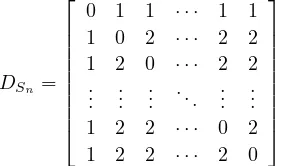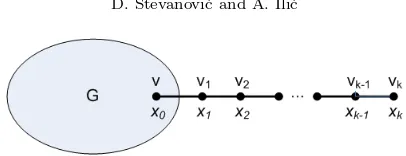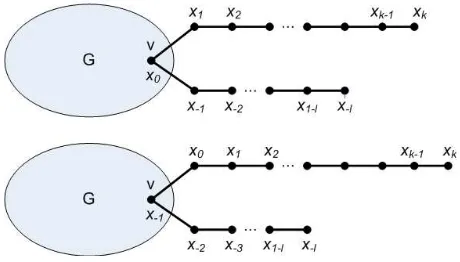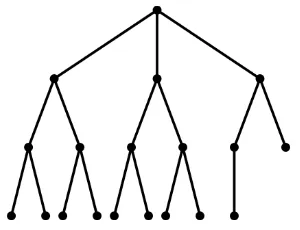DISTANCE SPECTRAL RADIUS OF TREES WITH
FIXED MAXIMUM DEGREE∗
DRAGAN STEVANOVI ´C† AND ALEKSANDAR ILI ´C‡
Abstract. Distance energy is a newly introduced molecular graph-based analog of the total
π-electron energy, and it is defined as the sum of the absolute eigenvalues of the molecular distance matrix. For trees and unicyclic graphs, distance energy is equal to the doubled value of the distance spectral radius. In this paper, we introduce a general transformation that increases the distance spectral radius and provide an alternative proof that the pathPnhas the maximal distance spectral
radius among trees on nvertices. Among the trees with a fixed maximum degree ∆, we prove that the broom Bn,∆ (consisting of a star S∆+1and a path of length n−∆−1 attached to an arbitrary pendent vertex of the star) is the unique tree that maximizes the distance spectral radius, and conjecture the structure of a tree which minimizes the distance spectral radius. As a first step towards this conjecture, we characterize the starlike trees with the minimum distance spectral radius.
Key words. Distance matrix, Distance spectral radius, Broom graph, Maximum degree.
AMS subject classifications.05C05, 05C12.
1. Introduction. Let G = (V, E) be a connected simple graph with n =|V|
vertices. For verticesu, v∈V, the distanceduv is defined as the length of the shortest path betweenuandv inG. The distance matrixD= (duv)u,v∈V is a symmetric real matrix, with real eigenvalues [7]. Thedistance spectral radius̺(G) =̺G ofGis the largest eigenvalue of the distance matrixD of a graphG.
Distance energy DE(G) is a newly introduced molecular graph-based analog of the total π-electron energy, and it is defined as the sum of the absolute eigenvalues of the molecular distance matrix. For trees and unicyclic graphs, distance energy is equal to the doubled value of the distance spectral radius. For more details on distance matrices and distance energy, see [6, 11, 15, 16, 19, 23].
Let T be a tree with n > 2 vertices, and let Λ1 ≥ Λ2 ≥ · · · ≥ Λn be the eigenvalues ofD=D(T) arranged in a non-increasing order. Merris in [18] obtained
∗Received by the editors June 4, 2009. Accepted for publication February 17, 2010. Handling Editor: Stephen J. Kirkland.
†University of Primorska—FAMNIT, Glagoljaˇska 8, 6000 Koper, Slovenia, and Mathematical Institute, Serbian Academy of Science and Arts, Knez Mihajlova 36, 11000 Belgrade, Serbia ([email protected]).
‡Faculty of Sciences and Mathematics, University of Niˇs, Viˇsegradska 33, 18000 Niˇs, Serbia (cor-responding author, [email protected]).
an interlacing inequality involving the distance and Laplacian eigenvalues ofT,
0>−µ2
1 ≥
Λ2≥ − 2
µ2 ≥
Λ3≥ · · · ≥ − 2
µn−1 ≥ Λn,
whereµ1≥µ2≥ · · · ≥µn= 0 are the Laplacian eigenvalues ofT.
Lete= (u, v) be an edge ofGsuch thatG′=G−eis also connected, and letD′ be the distance matrix ofG−e. The removal ofemay not create shorter paths than the ones inG, and therefore,Dij ≤D′ij for all i, j ∈V. Moreover, 1 =Duv < D′uv and by the Perron-Frobenius theorem, we conclude that
̺G< ̺G−e. (1.1)
In particular, for any spanning treeT ofG, we have that
̺G≤̺T. (1.2)
Similarly, adding a new edgef = (s, t) toGdoes not increase distances, while it does decrease at least one distance; the distance betweens and tis one in G+f and at least two inG. Again by the Perron-Frobenius theorem,
̺G+f < ̺G. (1.3)
The inequality (1.3) tells us immediately that the complete graph Kn has the minimum distance spectral radius among the connected graphs on n vertices, while the inequality (1.2) shows that the maximum distance spectral radius will be attained for a particular tree. Therefore, we focus our attention to trees in the rest of this paper.
Balaban et al. [1] proposed the use of̺Gas a molecular descriptor, while in [13], it was successfully used to infer the extent of branching and model boiling points of alkanes. Recently, in [25, 26], the authors provided the upper and lower bounds for ̺(G) in terms of the number of vertices, Wiener index and Zagreb index. Bala-subramanian in [2, 3] pointed out that the spectra of the distance matrices of many graphs such as the polyacenes, honeycomb and square lattice have exactly one positive eigenvalue, and he computed the spectrum of fullerenesC60andC70. Bapat in [4, 5] showed various connections between the distance matrixD(G) and Laplacian matrix
L(G) of a graph, and calculated the determinant and inverses of weighted trees and unicyclic graphs.
Fig. 1.1. The broom treeBn,∆ forn= 11and∆ = 6.
uniquely minimizes the largest eigenvalue of the adjacency matrix. Further, within the same class of trees, the broom has the minimum Wiener index and Laplacian-energy like invariant [21]. In [24], it was demonstrated that the broom has minimum energy among trees with the fixed diameter.
Subhi and Powers in [22] proved that forn≥3, the pathPn has the maximum distance spectral radius among trees on n vertices. Here, we extend the result by introducing a transformation that strictly increases the distance spectral radius of a tree and present an alternative proof of this fact. In addition, we prove that among trees with a fixed maximum degree ∆, the broom graphBn,∆ has the maximal dis-tance spectral radius. As a corollary, we determine the unique tree with the second maximal distance spectral radius. We conclude the paper by posing a conjecture on the structure of the extremal tree that minimizes the distance spectral radius.
2. The star Sn has minimum distance spectral radius. The distance ma-trix ofSn has the form
DSn=
0 1 1 · · · 1 1 1 0 2 · · · 2 2 1 2 0 · · · 2 2
..
. ... ... . .. ... ... 1 2 2 · · · 0 2 1 2 2 · · · 2 0
.
Letxbe an eigenvector ofDSncorresponding to the spectral radius̺Sn. Letabe the component ofxat the center ofSn. Since̺Sn is a simple eigenvalue of DSn by the Perron-Frobenius theorem, and all leaves are similar to each other, we may denote by
bthe component ofxat each leaf ofSn. The eigenvalue equationDSnx=̺Snxgives the system
(n−1)b=̺Sna,
which, after eliminatinga and b, yields a quadratic equation in ̺Sn, whose positive solution is
̺Sn=n−2 + p
(n−2)2+ (n−1).
The Wiener index ofGis the sum of distances between all pairs of vertices,
W(G) = X u,v∈V
d(u, v).
The Wiener index is considered as one of the most useful topological indices having a high correlation with many physical and chemical properties of molecular compounds. The huge majority of chemical applications of the Wiener index deal with acyclic organic molecules. For recent results and applications of the Wiener index, see [8].
Theorem 2.1 ([14]). Let Gbe a connected graph withn >2 vertices. Then
̺G≥
2W(G)
n ,
(2.1)
with equality if and only if the row sums ofD are all equal.
For trees onn≥3 vertices, the strict inequality in (2.1) holds. Now, letT 6∼=Sn be an arbitrary tree onnvertices, with the distance matrixD.
According to [9], among the trees onn≥4 vertices, the starSn has the smallest Wiener index, equal to (n−1)2, and the next smallest Wiener index, equal ton2−n−2, is attained by the starSn−1 with a pendent edge attached to one of its leaves. Thus,
̺T ≥ 2
n(n
2−n−2)> n−2 +p
(n−2)2+ (n−1) =̺ Sn,
forn≥4.
3. The path Pn has the maximum distance spectral radius. LetGbe a simple graph andv one of its vertices. For k, l ≥0, we denote byG(v, k) the graph obtained from G∪Pk by adding an edge between v and the end vertex of Pk (see Figure 3.1), and by G(v, k, l) the graph obtained from G∪Pk∪Pl by adding edges betweenv and one of the end vertices in bothPk andPl (see Figure 3.2). The main ingredient of our proof will be the lemma that fork≥l≥1,
̺G(v,k+1,l−1)> ̺G(v,k,l).
In order to prove this lemma, we first need an auxiliary result on the components of the principal eigenvector alongPk inG(v, k).
Fig. 3.1. Principal eigenvector components inG(v, k).
components ofxalongPk, starting with the vertex ofPkadjacent tov(see Figure 3.1). Ifs denotes the sum of components ofx, then there exist constantsak=a(̺, s, x0, k) andbk =b(̺, s, x0, k)such that
xi =akti1+bkti2, 0≤i≤k,
wheret1,2= 1 +1̺ ± √2̺+1
̺ .
Proof. Let D be the distance matrix of G(v, k). From the eigenvalue equation
̺x=Dx, written for componentsxj−1, xj andxj+1, for 1≤j≤k−1,
̺xj−1=xj+ 2xj+1+
X
u∈G
(duv+j−1)xu+ j−2
X
i=0
(j−1−i)xi+ k
X
i=j+2
(i−j+ 1)xi,
̺xj =xj−1+xj+1+
X
u∈G
(duv+j)xu+ j−2
X
i=0
(j−i)xi+ k
X
i=j+2
(i−j)xi,
̺xj+1 = 2xj−1+xj+
X
u∈G
(duv+j+ 1)xu+ j−2
X
i=0
(j+ 1−i)xi+ k
X
i=j+2
(i−j−1)xi,
we obtain the recurrence equation
2̺xj+ 2xj =̺xj−1+̺xj+1, (3.1)
whose characteristic equation has roots
t1,2= 1 + 1
̺± √
2̺+ 1
̺ , 0< t2<1< t1.
On the other hand, the eigenvalue equation̺x =Dx written for components xk−1 andxk,
̺xk−1=xk+
X
u∈G
(duv+k−1)xu+ k−2
X
i=0
(k−1−i)xi,
̺xk =xk−1+
X
u∈G
(duv+k)xu+ k−2
X
i=0
yields
̺xk−̺xk−1=s−2xk. (3.2)
We may use the recurrence equation (3.1) to formally extend the sequence x0, x1,
. . . , xk with new terms xk+1, xk+2, . . ., so that it represents a particular solution of (3.1). In such case, the equation in (3.2) may be rewritten as
̺xk+1=s+̺xk. (3.3)
From the theory of linear recurrence equations, there exist constantsak andbk such that fori≥0 it holds
xi =akti1+bkti2.
The values ofak andbk may be obtained from the boundary conditions, i.e., the value ofx0and the equation (3.3),
x0=ak+bk, (3.4)
s/̺=aktk1(t1−1) +bktk2(t2−1). (3.5)
Having in mind thatt2= t11, the equation (3.5) is further equivalent to
ak−
bk
t2k+11 = s/̺
(t1−1)tk1
.
(3.6)
From (3.4) and (3.6) we finally get:
ak = 1
1 +t2k+11 x0+ s ̺
tk+11 t1−1
!
,
(3.7)
bk = 1 1 +t2k+11
x0t2k+11 −
s ̺
tk+11
t1−1
!
.
(3.8)
[image:6.612.144.361.610.673.2]The previous lemma allows us to compare the sum of components of the principal eigenvector along two pendent paths attached to the same vertex.
Lemma 3.2. Letxbe a positive eigenvector ofG(v, k, l),k, l≥1, corresponding to
̺=̺G(v,k,l). Denote byx0the component ofxatv, byx1, . . . , xk the components ofx alongPk, starting with the vertex ofPkadjacent tov, and byy1, . . . , ylthe components of xalong Pl, starting with the vertex of Pl adjacent to v (see Figure 3.2). If k≥l, then
k
X
i=0
xi≥ l
X
j=0
yj.
Proof. Letsdenote the sum of components ofx, and lett= 1 +1 ̺+
√ 2̺+1
̺ . From Lemma 3.1 we get
xi=akti+bk/ti, 1≤i≤k,
yj =alti+bl/ti, 1≤j≤l,
whereak, bk, al andblare given by (3.7) and (3.8). Now, we have
k
X
i=1
xk = k
X
i=1
akti+bk/ti
=ak
t(tk
−1)
t−1 +bk
tk
−1
tk(t−1)
= 1
1 +t2k+1
x0t(t 2k
−1)
t−1 +
s ̺
t(tk
−1)(tk+1−1) (t−1)2
,
=x0f(k) +
s ̺g(k),
where
f(x) = t(t 2x−1)
(1 +t2x+1)(t−1) and g(x) =
t(tx−1)(tx+1−1) (1 +t2x+1)(t−1)2.
Similarly,
l
X
j=1
yl=x0f(l) +s
̺g(l).
Sincet >1, the functionsf(x) andg(x) have positive first derivatives,
f′(x) = 2t2x+1(t+ 1) lnt
(t−1)(t2x+1+ 1)2 and g′(x) =
tx+1(t+ 1)(t2x+1−1) lnt (t−1)2(t2x+1+ 1)2 .
Therefore, the function f(x) and g(x) are monotonically increasing in x, and from
that
k
X
i=1
xi=x0f(k) +
s
̺g(k)≥x0f(l) + s ̺g(l) =
l
X
j=1
yj.
We are now in a position to prove the main lemma in this section.
Lemma 3.3. Let Gbe a simple graph andv one of its vertices. Ifk≥l≥1, then
̺G(v,k,l)< ̺G(v,k+1,l−1). (3.9)
Proof. Let D be the distance matrix of G(v, k, l) and D∗ the distance matrix ofG(v, k+ 1, l−1). Letxbe a positive eigenvector ofD corresponding to ̺G(v,k,l), let x0 be the component of x at v, x1, . . . , xk the components of x along Pk, and
[image:8.612.141.371.358.489.2]x−1, x−2, . . . , x−lthe components of xalongPl, as illustrated in Figure 3.3.
Fig. 3.3.Graphs G(v, k, l)andG(v, k+ 1, l−1).
We may suppose that the graphG(v, k+ 1, l−1) is obtained fromG(v, k, l) by “shifting” the pathsPkandPlfor one position each overv. Suppose further that each vertex “carries” its own x-component during this transformation, and let x∗ be the vector obtained in this way, as illustrated in Figure 3.3. It follows thatx∗Tx∗=xTx. On the other hand, the productxTDxcan be partitioned into three sums
xTDx = X
u,w∈G−v
duwxuxw+ k
X
i=−l i−1
X
j=−l
|i−j|xixj+
X
u∈G−v k
X
i=−l
(duv+|i|)xuxi,
while the product x∗TD∗x∗ can be partitioned into four sums (the first two sums correspond to the first two sums in the productxTDx)
x∗TD∗x∗= X
u,w∈G−v
duwxuxw+ k
X
i=−l i−1
X
j=−l
+ X u∈G−v
X
i=0
(duv+|i|+ 1)xuxi+
X
u∈G−v
X
i=−l
(duv+|i| −1)xuxi
=xTDx+ x 0+
k
X
i=1
xi− −1
X
i=−l
xi
! X
u∈G−v
xu.
Sincek≥l≥1, it follows from Lemma 3.2 that
k
X
i=1
xi≥ −1
X
i=−l
xi,
so that
x∗TD∗x∗
≥xTDx+x 0
X
u∈G−v
xu> xTDx.
Sincexis an eigenvector ofD corresponding to ̺G(v,k,l), from the Rayleigh quotient we get
̺G(v,k+1,l−1)= sup z6=0
zTD∗z
zTz ≥
x∗TD∗x∗
x∗Tx∗ >
xTDx
xTx =̺G(v,k,l).
Therefore, we showed that fork≥l≥1,
̺G(v,k,l)< ̺G(v,k+1,l−1)< ̺G(v,k+2,l−2)<· · ·< ̺G(v,k+l,0). (3.10)
Let T be a tree with the maximum distance spectral radius among trees on n
vertices. Suppose that the maximum vertex degree in T is at least three. Letv be at the largest distance from the center ofT among the vertices ofT having degree at least three. Then T can be represented asG(v, k, l) for some subgraphG, k and l, withk≥l≥1. For the treeT′=G(v, k+l,0), we have̺T < ̺T′ by (3.10), which is a contradiction with the choice ofT.
Thus,Thas maximum vertex degree two, i.e., the tree with the maximum distance spectral radius is a pathPn.
4. Trees with the fixed maximum degree. The path is a unique tree with ∆ = 2, while the starSn is the unique tree with ∆ =n−1. Therefore, we can assume that 3≤∆≤n−2.
Theorem 4.1. LetT 6∼=Bn,∆be an arbitrary tree onnvertices with the maximum vertex degree ∆. Then
Proof. Fix a vertexvof degree ∆ as a root. LetT1, T2, . . . , T∆be maximal disjoint trees attached atv. We can repeatedly apply the transformation from Lemma 3.3 at any vertex of degree at least three with the largest eccentricity from the root in every tree Ti, as long as Ti does not become a path. By Lemma 3.3, it follows that each application of this transformation strictly decreases its distance spectral radius.
When all treesT1, T2, . . . , T∆turn into paths, we can again apply the inequalities (3.10) at the vertexv as long as there exist at least two paths of length at least two, further decreasing the distance spectral radius. At the end of this process, we arrive at the broomBn,∆.
Next, for ∆>2, we can apply the transformation of Lemma 3.3 at the vertex of degree ∆ inBn,∆ and obtainBn,∆−1. Thus,̺(Bn,∆)< ̺(Bn,∆−1) for ∆>2, which shows the chain of inequalities
̺(Sn) =̺(Bn,n−1)< ̺(Bn,n−2)<· · ·< ̺(Bn,3)< ̺(Bn,2) =̺(Pn).
From the proof of Theorem 4.1, it follows that Bn,3 has the second maximum distance spectral radius among trees onnvertices.
[image:10.612.182.332.496.611.2]A complete ∆-ary tree is defined as follows. Start with the root having ∆ children. Every vertex different from the root, which is not in one of the last two levels, has exactly ∆−1 children. While in the last level all nodes need not exist, those that do fill the level consecutively (see Figure 4.1). Thus, at most one vertex on the level before the last has its degree different from ∆ and 1.
Fig. 4.1. The complete 3-ary tree of order19.
A computer search among trees with up to 24 vertices revealed that complete ∆-ary trees attain the minimum values of the distance spectral radius among the trees with the minimum vertex degree ∆. Based on this argument and the above-mentioned empirical observations, we pose the following.
Conjecture 4.2. A complete ∆-ary tree has the minimum distance spectral radius ̺(T)among trees on nvertices with maximum degree∆.
While we do not have the proof of the above conjecture at the moment, we make a humble step forward by characterizing starlike trees which minimize the distance spectral radius. A ∆-starlike tree T(n1, n2, . . . , n∆) is a tree composed of the root vertexv, and the pathsP1, P2, . . . , P∆of lengthsn1, n2, . . . , n∆attached atv. There-fore, the number of vertices ofT(n1, n2, . . . , n∆) equals n=n1+n2+. . .+n∆+ 1. The ∆-starlike tree isbalancedif all paths have almost equal lengths, i.e.,|ni−nj| ≤1 for every 1≤i≤j≤∆. Notice that the broomBn,∆=T(1,1, . . . ,1, n−∆−1) is a ∆-starlike tree.
Theorem 4.3. The balanced∆-starlike tree has minimum distance spectral radius among∆-starlike trees of order n.
Proof. LetT =T(n1, . . . , n∆) be an arbitrary ∆-starlike tree. If there exists i and j, 1≤i, j ≤∆, such that|ni−nj| >1, then we can strictly increase its even spectral moments by applying Lemma 3.3 repeatedly until we obtain ∆-starlike trees with paths of lengths⌊ni+nj
2 ⌋and⌈ ni+nj
2 ⌉instead ofni andnj. The minimality of the distance spectral radius in such trees is shown analogously using Theorem 4.1.
Acknowledgment. This work is supported by Research Grant 144007 and 144015G of the Serbian Ministry of Science and Technological Development and the research program P1-0285 of the Slovenian Agency for Research. We gratefully ac-knowledge the suggestions from an anonymous referee and Sonja Mileti´c that helped in improving this article.
REFERENCES
[1] A.T. Balaban, D. Ciubotariu, and M. Medeleanu. Topological indices and real number vertex invariants based on graph eigenvalues or eigenvectors.J. Chem. Inf. Comput. Sci., 31:517– 523, 1991.
[2] K. Balasubramanian. Computer generation of distance polynomials of graphs. J. Comput. Chem., 11:829–836, 1990.
[3] K. Balasubramanian. A topological analysis of theC60buckminsterfullerene andC70based on distance matrices.Chem. Phys. Lett., 239:117–123, 1995.
[5] R.B. Bapat, S.J. Kirkland, and M. Neumann. On distance matrices and Laplacians. Linear Algebra Appl., 401:193–209, 2005.
[6] V. Consonni and R. Todeschini. New spectral indices for molecule description. MATCH Commun. Math. Comput. Chem., 60:3–14, 2008.
[7] D. Cvetkovi´c, M. Doob, and H. Sachs.Spectra of Graphs – Theory and Application, 3rd edition. Johann Ambrosius Barth, Heidelberg, 1995.
[8] A. Dobrynin, R. Entringer, and I. Gutman. Wiener index of trees: theory and applications.
Acta Appl. Math., 66:211–249, 2001.
[9] H. Dong and X. Guo. Ordering trees by their Wiener indices. MATCH Commun. Math. Comput. Chem., 56:527–540, 2006.
[10] M. Fischermann, A. Hoffmann, D. Rautenbach, L. Sz´ekely, and L. Volkmann. Wiener index versus maximum degree in trees.Discrete Appl. Math., 122:127–137, 2002.
[11] A. Graovac, G. Jashari, and M. Strunje. On the distance spectrum of a cycle. Apl. Mat., 30:286–290, 1985.
[12] I. Gutman, B. Furtula, V. Markovi´c, and B. Gliˇsi´c. Alkanes with greatest Estrada index. Z. Naturforsch., 62(a):495–498, 2007.
[13] I. Gutman and M. Medeleanu. On the structure–dependence of the largest eigenvalue of the distance matrix of an alkane. Indian J. Chem. A, 37:569–573, 1998.
[14] G. Indulal. Sharp bounds on the distance spectral radius and the distance energy of graphs.
Linear Algebra Appl., 430:106–113, 2009.
[15] G. Indulal and I. Gutman. On the distance spectra of some graphs. Math. Commun., 13:123– 131, 2008.
[16] G. Indulal, I. Gutman, and A. Vijayakumar. On distance energy of graphs.MATCH Commun. Math. Comput. Chem., 60:461–472, 2008.
[17] W. Lin and X. Guo. On the largest eigenvalues of trees with perfect matchings, J. Math. Chem., 42:1057–1067, 2007.
[18] R. Merris. The distance spectrum of a tree. J. Graph Theory, 14:365–369, 1990.
[19] Z. Mihali´c, D. Veljan, D. Ami´c, S. Nikoli´c, D. Plavˇsi´c, and N. Trinajsti´c. The distance matrix in chemistry.J. Math. Chem., 11:223–258, 1992.
[20] S. Simi´c and D. Toˇsi´c. The Index of Trees with Specified Maximum Degree.MATCH Commun. Math. Comput. Chem., 54:351–362, 2005.
[21] D. Stevanovi´c. Laplacian–like energy of trees. MATCH Commun. Math. Comput. Chem., 61:407–417, 2009.
[22] R. Subhi and D. Powers. The distance spectrum of the pathPnand the first distance eigenvector
of connected graphs.Linear Multilinear Algebra, 28:75–81, 1990.
[23] R. Todeschini and V. Consonni. Handbook of Molecular Descriptors. Wiley–VCH, Weinheim, 2000.
[24] W. Yan and L. Ye. On the minimal energy of trees with a given diameter. Appl. Math. Lett., 18:1046–1052, 2005.
[25] B. Zhou. On the largest eigenvalue of the distance matrix of a tree. MATCH Commun. Math. Comput. Chem., 58:657–662, 2007.




